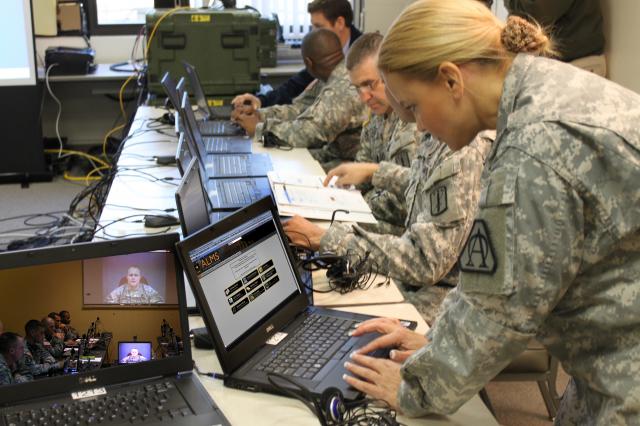Portable professional development classrooms that can be set up virtually anywhere are currently being used by units in Afghanistan and Iraq.
The classrooms are so portable that one unit in Afghanistan reportedly created a plywood structure to house theirs.
These mini-schoolhouses are part of an initiative called the Deployed Digital Training Campus, or DDTC, developed by the Army’s Distributed Learning System, aiming to provide deployed Soldiers with the ability to work on their military education while overseas. By providing brigade-sized units with a DDTC as part of their deployment equipment, leaders can ensure their Soldiers’ education doesn’t fall behind, even when stationed at primitive outposts.
Each DDTC is equipped with 20 laptop workstations, internet accessibility, video tele-training, voice over IP or VOIP, designated satellite access, and can be set up in less than two hours. The DDTC also puts Soldiers in direct connection with more than 1,200 pre-loaded Army Learning Management System courses.
Glenn Maravillas, the deputy project director for DDTC, said many times Soldiers don’t have access to the equipment needed to work on their professional development while deployed — something that can delay promotions.
“It provides Soldiers and civilians who are deployed a means to access training, and by completing training, gain promotion points, so they can move on in rank,” Maravillas said.
Maravillas noted that some units without much dwell time also find it hard to complete professional training while at home.
“Noncommissioned officers like the concept because they can schedule time for their Soldiers to work on their schooling when they have down time,” Maravillas noted.
The DDTC classrooms also have another advantage: they are classified capable if needed. Units can also use the teleconferencing feature to talk to their rear detachment at home, or their replacement unit, Maravillas said.
Brigades can request a DDTC from their higher headquarters as they are readying for deployment, and certify unit system operators with a three-day training course. Then a DDTC will be issued to the brigade on a hand-receipt and returned after the deployment like any other piece of equipment.
Maravillas noted that DDTCs fall within the Chief of Staff of the Army’s Learning Concept 2015, which stresses access to technology to enable education.
The first DDTC was sent overseas last year and there are currently six campuses in deployed locations, with plans for a total of 50 to be developed by 2015. And the capability is not limited to active-duty units — Reserve and National Guard brigades can request them as well.










